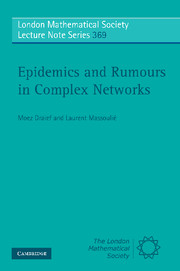Book contents
- Frontmatter
- Contents
- Introduction
- PART I SHAPELESS NETWORKS
- 1 Galton–Watson branching processes
- 2 Reed–Frost epidemics and Erdős–Rényi random graphs
- 3 Connectivity and Poisson approximation
- 4 Diameter of Erdős–Rényi graphs
- 5 From microscopic to macroscopic dynamics
- PART II STRUCTURED NETWORKS
- References
- Index
2 - Reed–Frost epidemics and Erdős–Rényi random graphs
Published online by Cambridge University Press: 25 January 2011
- Frontmatter
- Contents
- Introduction
- PART I SHAPELESS NETWORKS
- 1 Galton–Watson branching processes
- 2 Reed–Frost epidemics and Erdős–Rényi random graphs
- 3 Connectivity and Poisson approximation
- 4 Diameter of Erdős–Rényi graphs
- 5 From microscopic to macroscopic dynamics
- PART II STRUCTURED NETWORKS
- References
- Index
Summary
Introduction
The Reed–Frost model is a particular example of an SIR (susceptible-infectiveremoved) epidemic process. It is one of the earliest stochastic SIR models to be studied in depth, because of its analytical tractability. In the general SIR model, the population initially consists of healthy individuals and a small number of infected individuals. Infected individuals encounter healthy individuals in a random fashion for a given period known as the infectious period and then are removed and cease spreading the epidemic. Alternatively, in the context of rumour spreading, healthy individuals correspond to nodes that ignore the rumour whereas infected individuals are nodes that initially hold the rumour and actively pass it on to others. Removed individuals correspond to nodes that cease spreading the rumour, or stiflers.
The Reed–Frost epidemic corresponds to a discrete-time version of the SIR model where the infectious period lasts one unit of time. Another commonly used model assumes that infectious periods are independent and identically distributed (i.i.d.) according to an exponential distribution, so that the system evolves as a continuous-time Markov process. This continuous-time SIR model is amenable to the analysis presented in Chapter 5 whereby the dynamics of the Markovian epidemic process is approximated by the solution of a set of differential equations.
The basic version of the Reed–Frost model is as follows. A set of n individuals is given, indexed by i ∈ {1, …, n}.
- Type
- Chapter
- Information
- Epidemics and Rumours in Complex Networks , pp. 19 - 34Publisher: Cambridge University PressPrint publication year: 2009



